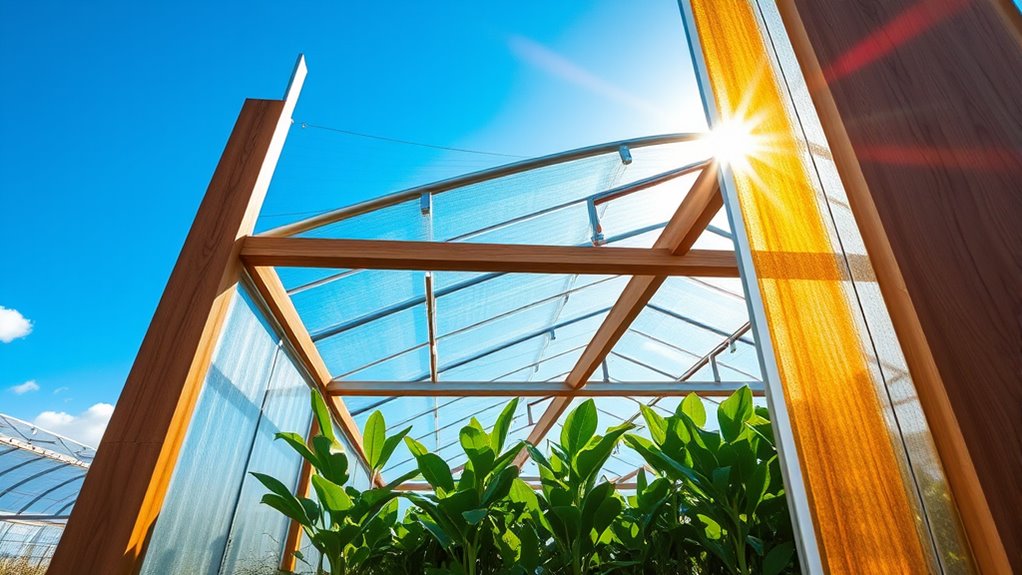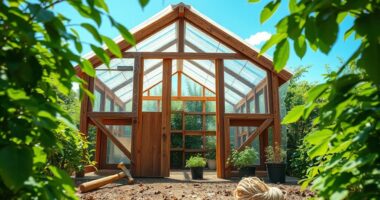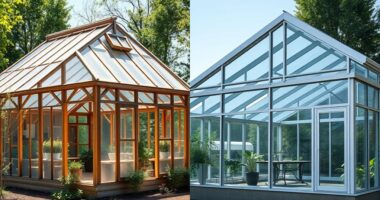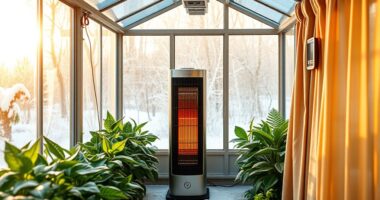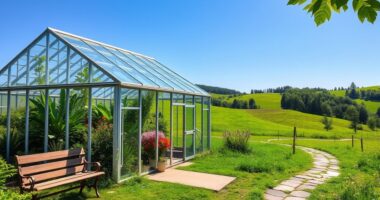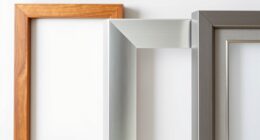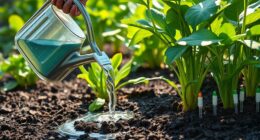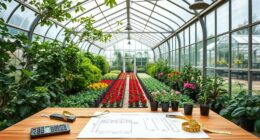When choosing greenhouse frame materials, consider wood, metal, and PVC. Wood offers aesthetic appeal and natural insulation but needs regular maintenance. Metal frames like aluminum and galvanized steel are durable and pest-resistant but can be costly. PVC is budget-friendly and lightweight, perfect for small structures but lacks long-term strength. Each option has its pros and cons, and your choice should fit your climate, budget, and style preferences. Discover more about what suits your greenhouse best.
Key Takeaways
- Wood frames offer a natural aesthetic and superior insulation but require regular maintenance to prevent decay and pest issues.
- Metal frames, such as galvanized steel or aluminum, provide durability and minimal maintenance but can be pricier and less attractive than wood.
- PVC frames are budget-friendly and lightweight, making them suitable for temporary structures, but lack the strength for long-term use.
- Consider local climate; galvanized steel is ideal for harsh conditions, while wood provides good insulation in moderate climates.
- Assess personal preferences and long-term goals to choose the most suitable frame material for your greenhouse needs.
Overview of Greenhouse Frame Materials
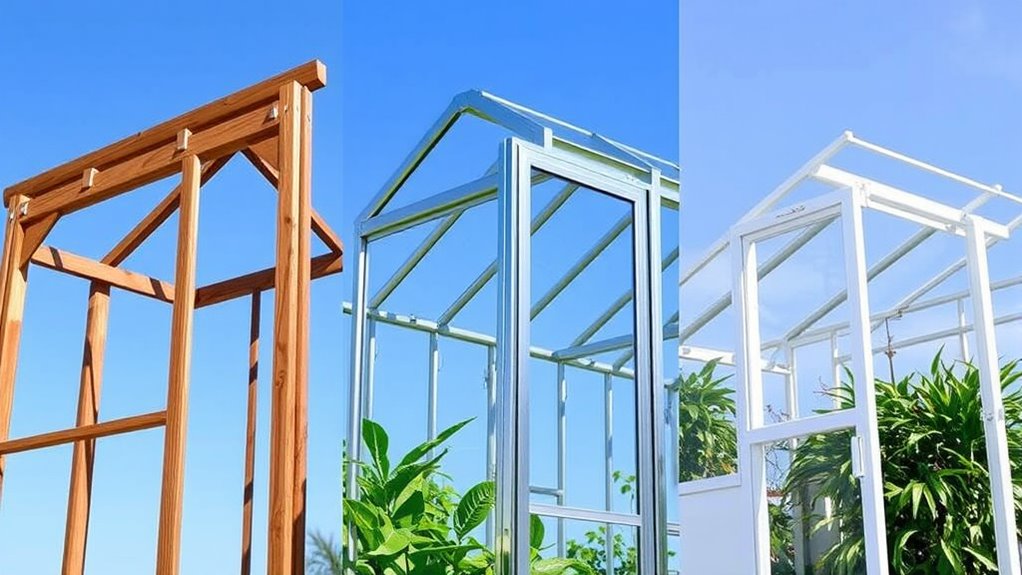
When choosing a greenhouse frame material, you’ll find several options that each offer unique benefits. You can choose from wood, metal (like galvanized steel and aluminum), and PVC.
Metal frames are typically more durable, making them a great long-term investment, while PVC is often the most affordable choice. If you’re looking for something lightweight and easy to work with, PVC might be ideal, but keep in mind it’s less durable than metal or wood.
Wood provides a natural aesthetic but requires more maintenance. Each material has its strengths, depending on your budget, climate, and personal preferences, so consider what matters most to you before making a decision for your greenhouse project.
Advantages of Wood Frames

When you choose wood frames for your greenhouse, you’re not just opting for durability; you’re also embracing a natural aesthetic that seamlessly blends with your garden. With the ability to customize and adjust the design, wood offers flexibility that other materials can’t match. Plus, its superior insulation properties help create the ideal environment for your plants year-round. Additionally, using wood aligns with sustainable living practices, promoting eco-friendly choices in your gardening endeavors.
Natural Aesthetic Appeal
Wooden greenhouse frames not only boast a traditional look but also seamlessly blend with your garden’s natural surroundings, enhancing its overall aesthetic.
Their classic, rustic appearance complements any landscape, creating a harmonious environment. The unique grain patterns of wood add a distinct visual charm, especially when you choose to stain or paint them to match your garden style or home color. This customization allows you to achieve the perfect look for your space. Additionally, wooden frames can increase your property value by adding beauty and functionality. Their earthy scent and vintage style appeal make them a timeless choice that draws attention, ensuring your greenhouse stands out while fitting in beautifully with nature. Moreover, incorporating natural materials can further enhance the organic feel of your greenhouse. Wooden structures also support a variety of marine life in nearby coastal areas, enriching the ecosystem around your garden. Furthermore, the use of wood in construction can promote digital literacy programs, encouraging a connection to nature while engaging with technology in sustainable gardening practices. This connection to nature can inspire a deeper appreciation for halal lifestyles, fostering a sense of community among those who prioritize ethical living. Additionally, using wood as a frame material can create a calming decor atmosphere in your greenhouse, contributing to a serene gardening experience.
Customization and Flexibility
Although many greenhouse options exist, the customization and flexibility of wood frames set them apart. With various wood types like cedar and oak, you can achieve the aesthetic that fits your garden. They’re easy to modify, allowing you to adapt to your design needs and climate conditions. Plus, wood frames support hanging plants and shelving, enhancing functionality.
| Feature | Benefit | Example |
|---|---|---|
| Material Variety | Different aesthetics | Cedar for a rustic look |
| Design Adaptability | Tailored to any space | Custom size for your yard |
| DIY Friendliness | Personal touch in construction | Build it yourself |
Wood frames combine beauty with practicality, making them a top choice for your greenhouse.
Better Insulation Properties
Customizing your greenhouse with wood frames not only enhances its aesthetic but also offers impressive insulation properties.
Wood provides excellent insulation, helping you maintain a stable temperature inside. With lower thermal conductivity than metal, it reduces heat transfer, keeping your plants cozy. Properly treated wood resists moisture, minimizing rot and improving overall insulation.
Compared to metal and PVC, wood frames outperform in insulation while also acting as thermal mass, absorbing and releasing heat slowly. For added efficiency, you can enhance insulation with sealants or additional materials.
Although wood may have higher initial costs, its durability and long-term energy savings make it a cost-effective choice. Overall, wood frames are a sustainable and effective option for your greenhouse.
Disadvantages of Wood Frames
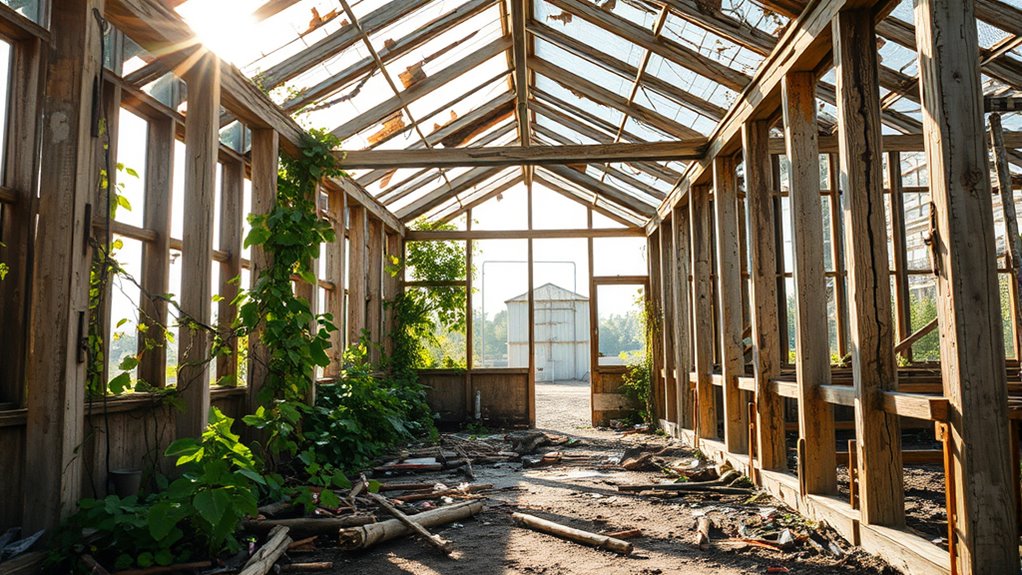
While wood frames can add charm to your greenhouse, they come with significant maintenance requirements.
You’ll need to regularly treat the wood to prevent rot and decay, which can be time-consuming and costly.
Additionally, wood’s vulnerability to pests like termites can pose serious risks to the structure’s integrity.
Maintenance Requirements
When you choose wood frames for your greenhouse, be prepared for significant maintenance requirements that can become a burden over time.
You’ll need to regularly treat the wood with preservatives and paint to prevent dry rot, which can be a time-consuming process. This often means temporarily removing plants due to fumes, adding to your workload.
Additionally, failure to properly seal the wood can lead to warping or rotting, requiring frequent inspections to catch any damage early.
While wooden frames can last many years, the ongoing maintenance costs may outweigh the initial savings, especially when compared to more durable materials like metal.
Ultimately, if you opt for wood, stay ready for continuous upkeep.
Pest Vulnerability
The maintenance challenges of wood frames extend beyond upkeep, as they also expose you to significant pest vulnerabilities. Wood is a prime target for termites, beetles, and woodworker ants, which can weaken the frame’s structure and compromise its integrity. High humidity in greenhouses only exacerbates these issues, creating an ideal environment for pest infestations.
| Pest Type | Impact |
|---|---|
| Termites | Can cause severe structural damage |
| Beetles | Infest wood, leading to decay |
| Woodworker Ants | Weaken the frame, risking collapse |
Treating wood with pesticides and preservatives is essential, but without preventative measures, the consequences of unchecked infestations can be dire. Regular inspections and proper moisture management are vital.
Advantages of Metal Frames
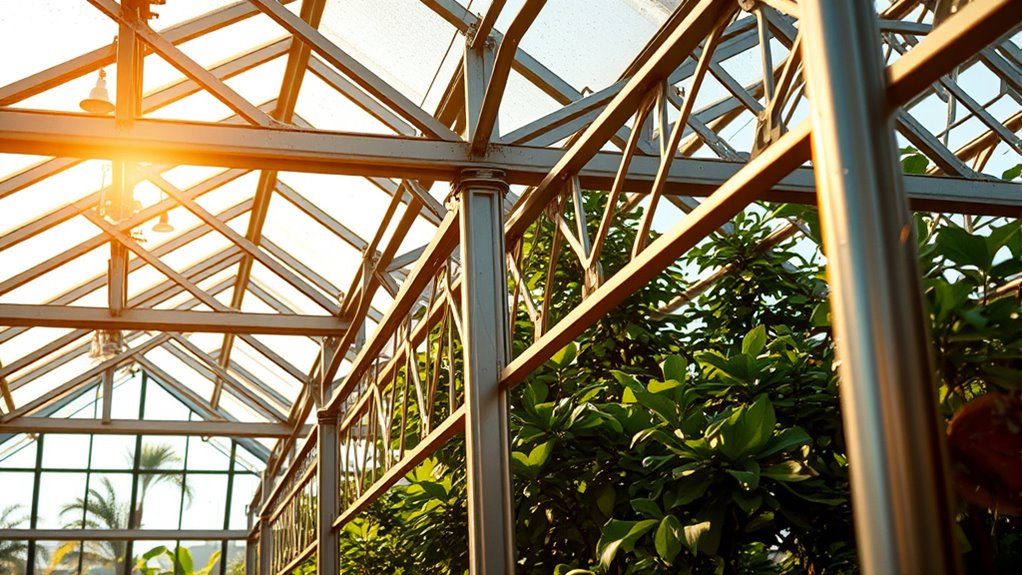
If you’re considering a greenhouse, metal frames offer a range of advantages that make them a superior choice.
Their durability guarantees they withstand harsh weather without losing integrity, while resistance to pests like termites means you won’t have to worry about damage.
High-quality galvanized steel or aluminum provides rust resistance, extending the lifespan of your greenhouse.
Metal frames require minimal maintenance, so you won’t need to repaint or treat them like wood.
Metal frames demand little upkeep, eliminating the need for repainting or treatments required by wooden structures.
They’re also customizable, allowing you to tailor designs to fit your space.
With cost-effectiveness and easy assembly, metal frames prove to be a practical choice.
Disadvantages of Metal Frames
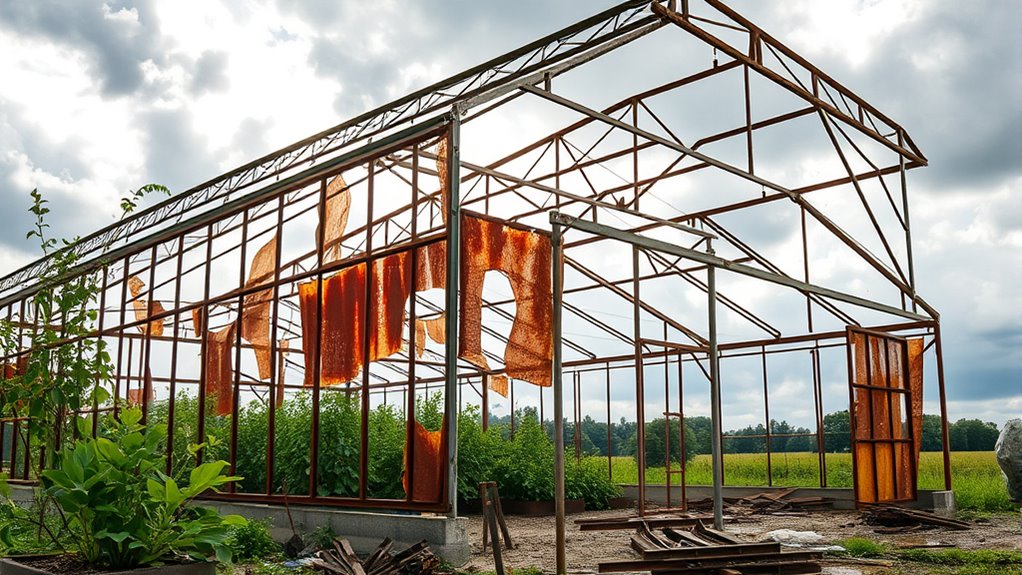
While metal frames offer numerous advantages, they also come with several disadvantages that you should consider.
First off, aluminum frames can be quite pricey, raising your overall greenhouse costs. Aesthetically, they mightn’t measure up to the warmth of wood, and finding the right sizes and shapes can be challenging.
Additionally, metal frames contribute to environmental concerns, as they require significant energy to produce and aren’t biodegradable. Their good heat conductivity can lead to temperature fluctuations and condensation issues, which could harm your plants.
Finally, while generally durable, they can rust if damaged and may need extra support in harsh weather, making maintenance a bit more demanding.
Characteristics of PVC Frames

When considering greenhouse options, PVC frames stand out due to their cost-effectiveness and lightweight nature.
You’ll find that PVC is the least expensive choice, making it budget-friendly. Its lightweight quality allows for easy transportation and construction, so you won’t need heavy-duty tools or skills.
PVC frames efficiently retain temperature, minimizing energy loss, and resist rotting and rusting, unlike wood or metal. Setting up your greenhouse becomes a breeze since PVC pipes are simple to cut and shape.
Plus, if you’re thinking of a temporary or small structure, PVC is ideal. Just keep in mind that while PVC has many advantages, its aesthetic appeal and structural integrity for larger builds mightn’t match other materials.
Comparing Durability and Maintenance

Choosing the right frame for your greenhouse goes beyond just cost and weight; durability and maintenance are key factors that can impact your long-term satisfaction.
Aluminum frames stand out for their remarkable durability, lasting up to 50 years with minimal upkeep. In contrast, galvanized steel frames offer good strength for 20-30 years but may require more maintenance due to condensation.
Wood frames, while aesthetically pleasing, last only 10-15 years and demand regular care to fight decay. PVC frames are lightweight and easy to handle but lack strength for long-term use.
Composite frames provide a balance of durability and low maintenance but can be harder to find.
Ultimately, consider how much time and effort you’re willing to invest in upkeep.
Choosing the Right Frame Material for Your Greenhouse

As you consider the best frame material for your greenhouse, several factors will influence your decision. Your local climate, budget, and aesthetic preferences play significant roles. Here’s a quick comparison to help you visualize your options:
| Material | Key Benefits |
|---|---|
| Wood | Natural look, good insulation |
| Aluminum | Lightweight, corrosion-resistant |
| Galvanized Steel | Strong, durable for harsh climates |
| PVC | Affordable, easy to work with |
Think about how each material aligns with your needs. For instance, if you live in a cold area, galvanized steel may be your best bet. However, if affordability is your priority, PVC could be the way to go. Choose wisely to create the greenhouse of your dreams!
Frequently Asked Questions
How Does Climate Affect the Choice of Frame Material?
Climate considerably affects your choice of frame material.
In humid areas, you’ll want moisture-resistant options, while snowy climates require strong materials that can handle heavy loads.
If you live in a sunny region, consider how UV exposure might impact your material’s durability.
Can I Combine Different Frame Materials in One Greenhouse?
Absolutely, you can mix and match frame materials in your greenhouse like a chef spices up a dish.
Combining different materials not only boosts durability but also enhances insulation and style.
Think of wood’s warmth paired with metal’s strength, creating a beautiful yet sturdy structure.
Just guarantee your materials work well together, and keep an eye on maintenance needs.
With the right blend, you’ll cultivate a thriving environment for your plants!
What Are the Best Practices for Maintaining Each Frame Type?
To maintain your greenhouse frame, start with regular inspections for any damage.
Clean it often to keep dirt from accumulating.
For wood, apply waterproof sealants to prevent decay; for metal, check for corrosion and apply protective coatings as needed.
If you’ve got PVC, make certain it’s UV-treated for longevity.
Always adapt your maintenance practices based on the specific material and local climate conditions to guarantee your greenhouse stays sturdy and functional.
How Do Frame Materials Impact Energy Efficiency in Greenhouses?
You might think all frame materials perform equally when it comes to energy efficiency, but that’s not the case.
Each material greatly impacts how well your greenhouse retains heat. Metal frames excel in thermal conductivity, helping maintain consistent temperatures, while wood offers some insulation but requires extra maintenance.
PVC, being lightweight, fails to provide adequate thermal mass. Your choice directly influences energy costs and the overall climate control of your greenhouse.
Are There Any Safety Concerns With Using Specific Frame Materials?
When considering safety concerns with different frame materials, you should weigh factors like durability, pest resistance, and fire risks.
Wood can rot and attract pests, while metal might rust and conduct heat, affecting your greenhouse’s interior.
PVC is lightweight and weather-resistant but may not withstand strong winds.
Regardless of the material, guarantee the structure’s integrity and maintain proper ventilation to prevent hazards and create a safe growing environment.
Conclusion
In choosing the right greenhouse frame, it’s clear that each material has its pros and cons. While wood offers natural beauty, it can succumb to rot. Metal boasts durability but might rust over time. PVC, though lightweight and resistant to decay, might not withstand heavy loads. Ultimately, your choice should hinge on your specific needs and local climate. Remember, investing in a sturdy frame is essential; after all, a solid foundation supports thriving plants.
